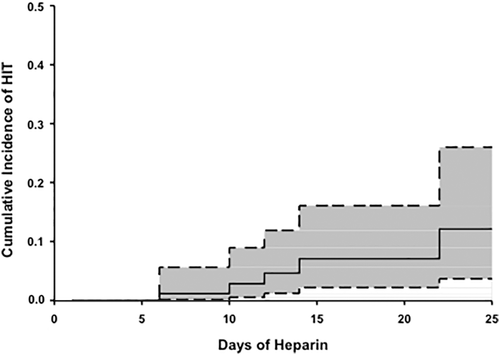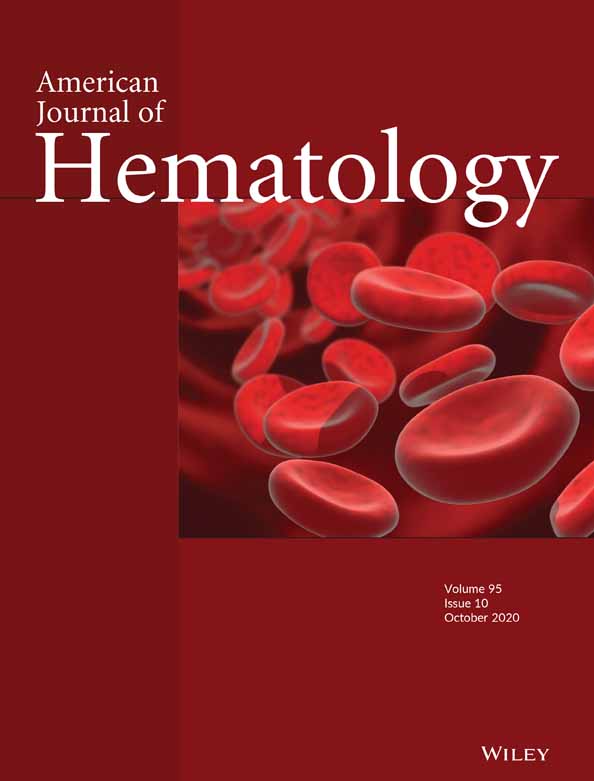Heparin induced thrombocytopenia antibodies in Covid-19
Coronavirus disease 2019 (Covid-19) is associated with venous and arterial thrombotic complications, especially among those hospitalized with more severe disease. Disturbances in coagulation indices are commonly observed in severe Covid-19 including marked elevations of plasma D-dimer that portend a poor prognosis. Emerging evidence points to the inadequacy of standard thromboprophylaxis. And, in an attempt to prevent thrombotic events and potentially limit microvasculature fibrin deposition, more aggressive thromboprophylaxis anticoagulation regimens are considered, including therapeutic dosing of unfractionated heparin (UFH).1 Heparin induced thrombocytopenia (HIT) is an uncommon but potentially life-threatening complication of heparin exposure. Autoimmune hematologic phenomena have increasingly been recognized during the course of Covid-19.2, 3 Accordingly, we evaluated the incidence of HIT among hospitalized patients with Covid-19 treated with intravenous, therapeutic-dose heparin.
Institutional Review Board approval was obtained. A retrospective cohort analysis was performed for patients hospitalized at Beth Israel Deaconess Medical Center with Covid-19 confirmed by PCR between February 1, 2020 to May 7, 2020 and received intravenous UFH for ≥5 days. A cut off of 5 days was selected based on the known natural history of HIT. The HIT antibody testing was ordered by the treating physicians and performed by latex immunoassay for anti-platelet factor 4/heparin antibodies (HemosIL HIT-Ab).4 Confirmatory testing performed by serotonin release assay (Versiti, Wisconsin). To account for death as a competing risk, estimation of the cumulative incidence of HIT was calculated by competing risk analyses (stcompet, Stata Corp, TX) along with 95% confidence intervals at 25 days from start of heparin infusion.
Among 439 hospitalized patients with Covid-19, 88 patients who received at least 5 days of UFH were included in the analyses. The target partial thromboplastin time was above 60 seconds in 84 patients and the remaining four patients the target was above 50 seconds. Median duration of heparin exposure was 11 days (IQR 7-15 days). The most common indications for therapeutic heparin were Covid-19 coagulopathy (N = 58), confirmed or presumed venous thromboembolism (N = 15), and atrial fibrillation (N = 15). Among eight patients where there was suspicion for HIT, five patients tested positive for HIT by latex immunoassay (Table S1). The cumulative incidence of positive HIT immunoassay assay was 12% at 25 days (95% CI, 4% to 26%, Figure 1). Direct thrombin inhibitors were administered following HIT diagnosis (argatroban N = 4, bivalirudin N = 1). One patient was identified with thrombotic complications in the setting of HIT, this included evidence of acute cerebrovascular infarct as well as extensive areas of splenic infarction. Three patients developed major hemorrhagic events. Three patients died during hospitalization of progressive respiratory failure, one was discharged, and one remains hospitalized.

Therapeutic UFH is commonly administered in order to mitigate the prothrombotic state in severe Covid-19. We report a cumulative incidence of detectable HIT antibodies of 12% at 25 days. In non-Covid-19 cohort analyses conducted in hospitalized medical populations, the rate of diagnosed HIT by antibody testing alone (ie, without serotonin release confirmation) is typically less than 3%.5, 6 For instance, in a cohort of 5415 patients receiving therapeutic heparin, the overall incidence was 0.76%.5
These results raise several important issues. First, while immunologic detection of auto-antibodies such as lupus anticoagulant appear to be prevalent among patients with Covid-19, whether or not these are pathologic is unclear. In our cohort, the majority of the positive HIT antibody tests were not definitively confirmed by serotonin release assay, which reinforces the importance of confirmatory testing. Second, while the benefit of empiric therapeutic heparin to mitigate the hypercoagulable state of Covid-19 is not established, the diagnosis of HIT necessitates the initiation of non-heparin anticoagulants. Three of the five patients diagnosed with HIT developed major hemorrhages after switching to direct thrombin inhibitors. Bleeding risks must be balanced in prothrombotic disorders and critically ill patients may have multiple risk factors, a recent paper showed that the rate of major bleeding in critically ill patients with Covid-19 was considerable.7 Lastly, the incidence of HIT commonly correlates with duration and intensity of heparin exposure. Even in the absence of immune hyperstimulation, prolonged hospitalizations are common with severe Covid-19 and thus an increased incidence of HIT would be expected.
This study is the first to investigate the incidence of HIT in hospitalized patients with Covid-19 being treated with therapeutic unfractionated heparin, however we acknowledge limitations including the limited sample size given the single center design. Given the retrospective design of the study, HIT testing was only performed when considered indicated by the treating providers. However cytopenias and thrombosis are common in critically ill patients and given the widespread use of heparin in hospitalized Covid-19 patients, it is possible that screening serologies would detect higher rates of HIT antibodies. This would lead to an underestimate of the true prevalence of HIT antibodies by detecting unsuspected patients. The latex immune turbidimetric assay used in our center is semi-quantitative with operating characteristics superior to the more common ELISA.4 The serotonin release assay, which is the confirmatory test, was performed in all four of the patients with low positive values, and only one was negative, belying that the antibodies detected in a majority of the cases were not false positives.
In this single center retrospective cohort study, we found a high incidence of HIT antibody positivity in critically ill Covid-19 patients being treated with therapeutic unfractionated heparin. Despite the limitations of the study design, our findings suggest that HIT may be an unrecognized clinical entity at least in a subpopulation of patients and merits further study. Considering the frequency of HIT following prolonged UFH exposure in the intensive care setting, we urge caution in the empiric use of intravenous UFH for the management of Covid-19 coagulopathy.
DISCLOSURES
JIZ reports research funding from Incyte and Quercegen; consultancy: Sanofi, CSL, Parexel; honoraria/advisory boards: Pfizer/BMS, Portola, Daiichi. KAB reports consultancy with Janssen. WCA is employed by DynaMed.




